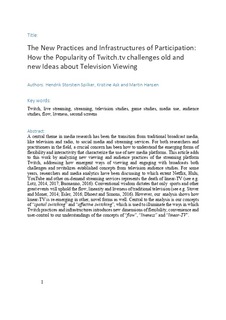| dc.contributor.author | Spilker, Hendrik Storstein | |
| dc.contributor.author | Ask, Kristine | |
| dc.contributor.author | Hansen, Martin | |
| dc.date.accessioned | 2019-03-22T08:32:05Z | |
| dc.date.available | 2019-03-22T08:32:05Z | |
| dc.date.created | 2018-10-29T10:14:03Z | |
| dc.date.issued | 2018 | |
| dc.identifier.citation | Information, Communication & Society. 2018, . | nb_NO |
| dc.identifier.issn | 1369-118X | |
| dc.identifier.uri | http://hdl.handle.net/11250/2591218 | |
| dc.description.abstract | A central theme in media research has been the transition from traditional broadcast media, like television and radio, to social media and streaming services. For both researchers and practitioners in the field, a crucial concern has been how to understand the emerging forms of flexibility and interactivity that characterize the use of new media platforms. This article adds to this work by analyzing new viewing and audience practices of the streaming platform Twitch, addressing how emergent ways of viewing and engaging with broadcasts both challenges and revitalizes established concepts from television audience studies. For some years, researchers and media analytics have been discussing to which extent Netflix, Hulu, YouTube and other on-demand streaming services represents the death of linear-TV [see, e.g., Lotz, A. D. (2014). The television will be revolutionized. New York, NY: New York University Press; Lotz, A. D. (2017). A treatise on internet-distributed television. Michigan, MI: Maize Books; Buonanno, M. (2016). (Not yet) the end of television: Editor’s introduction [Special issue]. Media and Communication, 4(3), 95–98]. Conventional wisdom dictates that only sports and other great events will uphold the flow, linearity and liveness of traditional television. However, our analysis shows how linear-TV is re-emerging in other, novel forms as well. Central to the analysis is the concepts of ‘spatial switching’ and ‘affective switching’, which is used to illuminate the ways in which Twitch practices and infrastructures introduces new dimensions of flexibility, convenience and user-control to flow, liveness and linear-TV. | nb_NO |
| dc.language.iso | eng | nb_NO |
| dc.publisher | Taylor & Francis | nb_NO |
| dc.relation.uri | https://www.tandfonline.com/doi/full/10.1080/1369118X.2018.1529193 | |
| dc.title | The New Practices and Infrastructures of Participation: How the popularity of Twitch.tv challenges old and new ideas about television viewing | nb_NO |
| dc.title.alternative | The New Practices and Infrastructures of Participation: How the popularity of Twitch.tv challenges old and new ideas about television viewing | nb_NO |
| dc.type | Journal article | nb_NO |
| dc.type | Peer reviewed | nb_NO |
| dc.description.version | acceptedVersion | nb_NO |
| dc.source.pagenumber | 15 | nb_NO |
| dc.source.journal | Information, Communication & Society | nb_NO |
| dc.identifier.doi | 10.1080/1369118X.2018.1529193 | |
| dc.identifier.cristin | 1624318 | |
| dc.relation.project | Norges forskningsråd: 205265 | nb_NO |
| dc.description.localcode | Locked until 16.4.2020 due to copyright restrictions. This is an [Accepted Manuscript] of an article published by Taylor & Francis in [Information, Communication & Society] on [16 Oct 2018], available at https://doi.org/10.1080/1369118X.2018.1529193 | nb_NO |
| cristin.unitcode | 194,67,25,0 | |
| cristin.unitcode | 194,62,40,0 | |
| cristin.unitname | Institutt for sosiologi og statsvitenskap | |
| cristin.unitname | Institutt for tverrfaglige kulturstudier | |
| cristin.ispublished | true | |
| cristin.fulltext | original | |
| cristin.qualitycode | 1 | |
